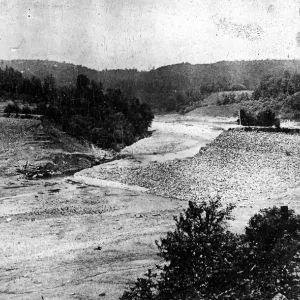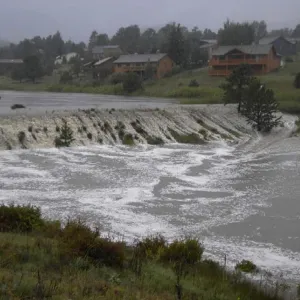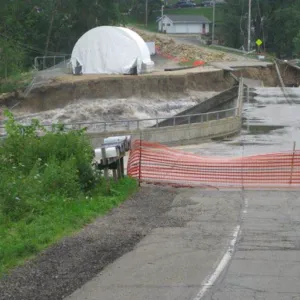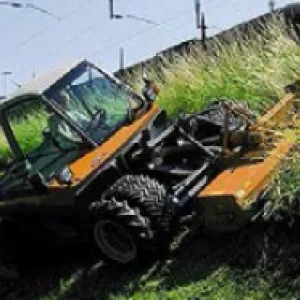Buffalo Creek Dam (West Virginia, 1972)
On February 26, 1972 at approximately 8:00 A.M., Coal Slurry Impoundment #3 at the Buffalo Creek coal mine in Logan County, West Virginia gave way sending millions of gallons of water and millions of cubic yards of coal slurry down the Buffalo Creek. Over the next three hours it would devastate the communities of Saunders, Pardee, Lorado, Craneco, Lundale, Stove, and 11 others. The wave washed away or demolished over 500 homes, left over 4,000 homeless and took the lives of 125 people. The impoundment was used as a settling pond for mining operation and was the third impoundment in that valley. Impoundments #1 and #2 were downstream of Impoundment #3 and subsequently failed as well. All three impoundments had been built with almost no engineering involvement. The only plans for Impoundment #3 was a sketch that had been drawn by the onsite vice president, Mr. Steve Dasovich. Inspections had been performed intermittently by the West Virginia Department of Natural Resources. They regularly found deficiencies that were left unaddressed and stated in a letter in April 1971 that all inspections covering a period from September 19, 1966 to March 25, 1971 had been unsatisfactory. One of the concerns was the lack of ability to handle large amounts of surface runoff, and the Department called for an emergency spillway to be installed. The mine did install a largely inadequate 24-inch pipe that they called the emergency spillway. It appears that there was little to no engineering involved in the design or installation of this spillway pipe.

Beginning on February 22, 1972, significant rainfall began to fall in the area. As the rain fell the water began to rise upstream of Impoundment #3. Because the elevation of the reservoir behind the dam was only controlled by water slowly seeping through the coal waste and the undersized spillway pipe, overtopping was a significant concern. Therefore, several site visits were made by both mine staff and community members. The authority for the dam was the onsite vice president who visited the dam many times and continued to insist that there was no need to fear. During his last visit (approximately two hours before the failure), he decided to add another spillway pipe. On his way to tell his staff to install it, he ran into the local Sherriff who had been called by locals because of the fear of the impoundment failing. He told the Sherriff, “The thing looks all right, we are going to do a little work on it.” Others were more concerned. Mr. Denny Gibson, a heavy equipment operator at the dam, visited the dam several times that morning and with each visit told several residents of the possibility of dam failure. His last visit was approximately 10 minutes before the dam failed.
The exact cause of failure is unknown. Several people visiting the dam reported that there was little to no freeboard and the water was still rising. Given the limited amount of spillway capacity, overtopping was a significant concern. However, those who visited the dam within minutes of failure noted that the pool had dropped significantly, reporting between 6 and 8 feet of freeboard. Also, downstream first-hand accounts noted an increased, muddy flow for a time before the over 30-foot wall of water hit. This indicates that internal erosion from increased hydrologic loading, or perhaps from seepage along the recently installed spillway pipe are more likely failure scenarios.
The Buffalo Creek disaster had significant impact on our nation. Because of this failure, hearings were held in the United States Senate. Senator Henry Jackson opened the hearings by stating in part, “These occurrences (pointing to Buffalo Creek and similar failures) point up the grim fact that there are innumerable dams in existence throughout the United States which are under no effective public control to insure that they were competently designed and constructed initially, that they are being adequately inspected and maintained, or that the design remains adequate under current hydrologic conditions in the watershed.” These hearings led to the passage of Public Law 92-367, created the National Dam Inspection Program, and gave Secretary of the Army authority to begin an inventory and inspection of all the nation’s dams.
References:
(1) Kelley, J.H. (1973). The Buffalo Creek Flood and Disaster: Official Report from the Governor’s Ad Hoc Commission of Inquiry. West Virginia Department of Arts, Culture and History.
(2) Stern, G.M. (1976). The Buffalo Creek Disaster. Vintage.
(3) U.S. Congress. (1972). Hearing before the Committee on Interior and Insular Affairs United States Senate July 20, 1972.
(4) U.S. Congress (1972). Public Law 92-367.
(5) History Channel. (2010). 1972 Buffalo Creek, Dam Collapse (West Virginia).
This case study summary was peer-reviewed by Gregory Richards, P.E., Gannett Fleming, Inc.







Lessons Learned

Dam incidents and failures can fundamentally be attributed to human factors.
Learn more
Dozens of dams can fail or be in danger of failing during a single event (i.e. swarming failures). Dam owners and regulators need to prepare for these types of events.
Learn more
Earth and rockfill embankment dams must be stable under the full range of anticipated loading conditions.
Learn more
Forensic investigations are needed for major dam failures and incidents in order to determine the history of the contributing physical and human factors, and the culminating physical failure modes and mechanisms.
Learn more
High and significant hazard dams should be designed to pass an appropriate design flood. Dams constructed prior to the availability of extreme rainfall data should be assessed to make sure they have adequate spillway capacity.
Learn more
Regular operation, maintenance, and inspection of dams is important to the early detection and prevention of dam failure.
Learn moreAdditional Lessons Learned (Not Yet Developed)
- Dams need to be designed by a professional engineer who has adequate experience in the design of dams.
- Dam designs need to be reviewed by competent professional engineer.
- Proper quality control and quality assurance during construction of dams is vital to the safe operation of dams.
- Dam inspections need to be performed by a competent professional, who has adequate knowledge and experience in inspecting such facilities.
- Tree roots, abandoned pipes and other penetrations into the dam can lead to failures or incidents.
- Upstream dam failures can fail downstream dams.

Buffalo Creek Disaster Remembered

Buffalo Creek Disaster Remembered 40 Years Later

Buffalo Creek Flood - An Act of God

Additional Resources Not Available for Download
- Stern, G.M. (1976). The Buffalo Creek Disaster. Vintage.





